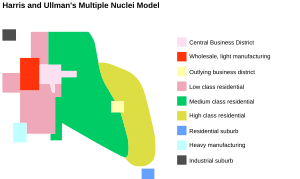Multiple nuclei model facts for kids
The Multiple Nuclei Model is a way to understand how cities grow and are organized. It suggests that a city doesn't just have one main center, like a downtown area. Instead, it can have several smaller business and activity centers, or "nuclei," spread out. This idea helps urban planners design and manage cities better.
Contents
What is the Multiple Nuclei Model?
This model explains that as a city gets bigger, its main downtown area, called the Central Business District (CBD), might not be able to serve everyone. Imagine a huge city where everyone has to travel to one single spot for shopping or work. It would be very crowded!
Instead, the Multiple Nuclei Model says that new centers pop up in different parts of the city. These new centers might be shopping malls, office parks, or industrial areas. Each new center becomes a magnet, attracting more businesses and people to its area.
How Cities Grow with Many Centers
Think of a city like a big puzzle. In the past, people thought all the important pieces were in the middle. But this model shows that important pieces can be found all over.
- New Business Areas: As a city grows, some shops and offices move away from the busy downtown. They might go to the edge of the city where land is cheaper.
- Attracting More Businesses: When a few businesses gather in a new spot, they attract others. For example, a big shopping mall might lead to restaurants and movie theaters opening nearby.
- Forming New Nuclei: Over time, these new clusters of businesses and activities become their own "nuclei" or centers. They serve the people living closer to them, reducing the need for everyone to go downtown.
- Specialized Areas: Some of these new centers might specialize. One area could become known for technology companies, another for hospitals, and another for factories.
This model helps us understand why different parts of a city look and feel unique. It shows how cities can be complex and have many important hubs.
Who Developed This Idea?
The Multiple Nuclei Model was created in 1945 by two smart geographers named Chauncy Harris and Edward Ullman. They were part of a group of thinkers known as the "Chicago School" who studied how cities develop.
Their idea was important because it was one of the first to suggest that cities don't always grow in simple circles or wedges. It showed that cities can have a more scattered and complex pattern of growth, with many important places besides just the main downtown.
Related pages


